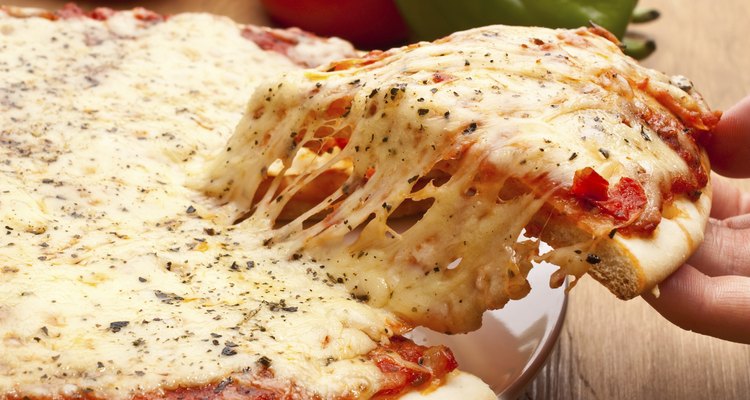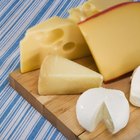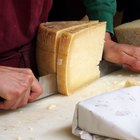
Olga Nayashkova/iStock/Getty Images
From tortillas to naan, pita to foccaccia, the world's cuisines offer a dizzying number of flatbreads. Some are eaten plain or used to wrap other foods, while others serve as a base for flavorful toppings. One of the latter -- the pizza -- has transcended its origins as an Italian import to become a permanent part of the American culinary landscape. Although its other toppings vary with the pizzaiola's whim, a substantial layer of cheese is usually a given.
Gooey, Melty Cheeses
The iconic image of pizza-eating for many people is one of long, stretchy strands of cheese sagging like telephone wires between the diner's teeth and the triangular slice. That gooey, chewy texture comes from mozzarella cheese, usually a variety produced especially for the pizza trade. Those industrial mozzarellas have low moisture content, making them easier to shred in volume. Provolone is often added to the cheese mixture, another cheese with an Italian pedigree but with a nuttier and more distinctive flavor than mozzarella. It helps form the puddle of melted cheese atop your pie, but adds little to the mozzarella's stringiness.
Sharp, Hard Cheeses
Although mozzarella knows no peers in the stretchiness department, its flavor can be rather bland. It's pleasantly rich, but not especially cheesy. To rectify that deficiency, pizza enthusiasts usually turn to hard grating cheeses such as Parmesan or Romano. The dried, long-aged cheeses have a concentrated cheese flavor even in their mass-produced industrial versions. A relatively small quantity, either sprinkled over the pie's sauce or tossed with the shredded mozzarella, can lend a distinct punch to the flavor of the finished pizza.
Pretty or "Primo" Cheeses
Some cheeses are used for their appearance as much as their culinary value. For example, the classic Margherita pizza is basically cheese, tomatoes and fresh basil. If slices of bocconcini -- little balls of fresh mozzarella -- are used, the pie visibly resembles a baked version of the classic Caprese salad. Feta, which melts poorly, is often diced or crumbled across pies for visual effect. Artisanal pizza-makers sometimes make a point of using authentic Italian "Mozzarella di Bufala," made from buffalo milk. It's moister and richer-flavored than industrial mozzarella, and less stringy.
A la Carte
Food writers often decry modern America's lack of deep culinary traditions, but that's also a strength. Unless you're cooking for your Italian nonna, there's no need to confine yourself to traditional pizza cheeses. For example, Swiss-born Gruyere melts beautifully and has a rich flavor, making it a great choice for pizza. If there's a cheese you love, give it a whirl. The mellow richness of Havarti or Monterey Jack, the sharp pungency of a Danish Blue or even the mushroom-like earthiness of a French-made Brie all have their virtues, and can be successfully incorporated into your own personal signature pizza.
Related Articles
List of High Temperature Cheeses

Aged Cheeses That Do Not Melt

Seasoning Ricotta Cheese for Lasagna

Cheeses Similar to Feta

Cooking Pizza With Fresh Mozzarella

Baking Brie Without Pastry

Differences Between French & Italian ...

Substitute for Shredded Parmesan Cheese

What Types of Cheeses Are Unpasteurized?

The Best Melting Cheeses

Can Pizza Be a Post-Workout Meal?

Which Cheeses Go With Honey Ham?

Can You Substitute Mascarpone With ...

Baking Brie With or Without the Rind

Pecorino Cheese Nutrition

Baking Pizza With Wraps

Difference Between White Cheddar & ...

Low Fat Substitute for Mascarpone
Can I Substitute Neufchatel for Cream ...

How Much Fat Is in Feta Cheese?
References
Writer Bio
Fred Decker is a trained chef and prolific freelance writer. In previous careers, he sold insurance and mutual funds, and was a longtime retailer. He was educated at Memorial University of Newfoundland and the Northern Alberta Institute of Technology. His articles have appeared on numerous home and garden sites including GoneOutdoors, TheNest and eHow.
Photo Credits
Olga Nayashkova/iStock/Getty Images